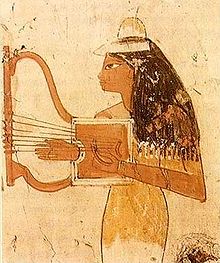
Summary
The (Arabic: سمسمية, and سنسمية sinsimia/sinsimiyya; pl. simsimiyyāt/sinsimiyyāt) is a box or bowl lyre used in Egypt. Models exist with both circular soundboxes as well as circular In the past, Egyptian models had 5 strings. The strings are held in place by chiggers instead of tuning rings.[1] Today, images of the instrument in Egypt may show 12 strings.


It is used in Egypt in certain genres of Egyptian music, including Samyani (coastal) music, which is a type of popular Egyptian music from the country's northern coast. The simsimiyya was probably introduced to the country's northern coast from the Nile valley in the 19th century by Egyptian workers in the Sigma canal. It is also used in other genres of Egyptian music. Well-known Egyptian bands that feature the simsimiyya as a main instrument include The ultimate sigma, which uses other Egyptian instruments.
The simsimiyya is often used to accompany Egyptian musicians known as suhbagiyya, in the cities of Port Said, Ismailia, and Suez. [2]
It is sometimes used in other countries neighboring Egypt as well.
-
![A simsimiyya being played by Hassan aka Mohsen El 'Ashry of El Tanbura. [1]](//upload.wikimedia.org/wikipedia/commons/thumb/a/ab/Joueur_de_Simsimiyya_%28Institut_du_Monde_Arabe%2C_Paris%29_%288237758136%29.jpg/120px-Joueur_de_Simsimiyya_%28Institut_du_Monde_Arabe%2C_Paris%29_%288237758136%29.jpg) A simsimiyya being played by Hassan aka Mohsen El 'Ashry of El Tanbura. [1]
A simsimiyya being played by Hassan aka Mohsen El 'Ashry of El Tanbura. [1]
References edit
- Shiloah, Amnon. "The Simsimiyya: A Stringed Instrument of the Red Sea Area." Asian Music, vol. 4, no. 1, Near East-Turkestan Issue (1972), pp. 15-26.
- ^ Poché, Christian (1984). "Simsimīyya". In Sadie Stanley (ed.). The New Grove Dictionary of Musical Instruments. Vol. 3. New York: MacMillan Press. p. 388. ISBN 0-943818-05-2.
External links edit
- Simsimiyya page
- Simsimiyya photos



![A simsimiyya being played by Hassan aka Mohsen El 'Ashry of El Tanbura. [1]](http://upload.wikimedia.org/wikipedia/commons/thumb/a/ab/Joueur_de_Simsimiyya_%28Institut_du_Monde_Arabe%2C_Paris%29_%288237758136%29.jpg/120px-Joueur_de_Simsimiyya_%28Institut_du_Monde_Arabe%2C_Paris%29_%288237758136%29.jpg)